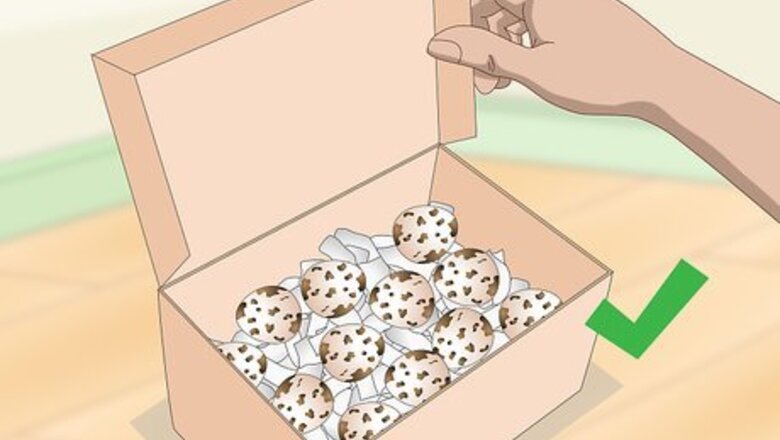
views
Collecting Fertile Eggs
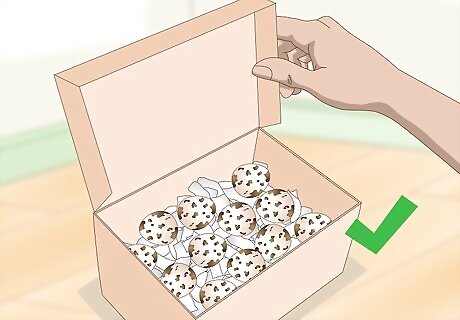
Purchase fertile quail eggs. You can order some quail eggs from sites such as Craigslist, eBay or Gumtree. You can also order fertile eggs from hatcheries online or buy some from a local hatchery or farm. The quantity of eggs you choose depends on the number of chicks you want to hatch and how many eggs can fit in your incubator. You might want to order more eggs than needed since some may get destroyed along the way. Many mail order companies only ship eggs in large batches, so check the seller’s policy before you buy to make sure you can get the quantity you want.
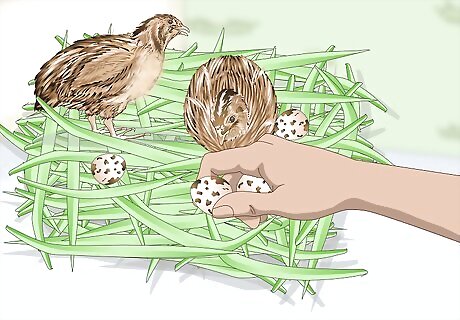
Collect eggs from your own quails if you have a breeding pair. If you have a male and a female together, the hen may have laid some fertile eggs for you. If you want your hen to lay some great-quality eggs, provide her with plenty of sunlight and supplemental lighting (up to 17 hours per day) and supplement her diet with calcium (crushed egg shells or oyster shells).Tip: Research the temperature needs of the species of quail you keep. When a quail habitat is maintained at an ideal temperature, your quail will eat more, leading to improved egg production. You may need to wait until your hen is mature enough to consistently produce eggs. For example, most bobwhite quail don’t begin laying eggs regularly until they are about 22 weeks old.
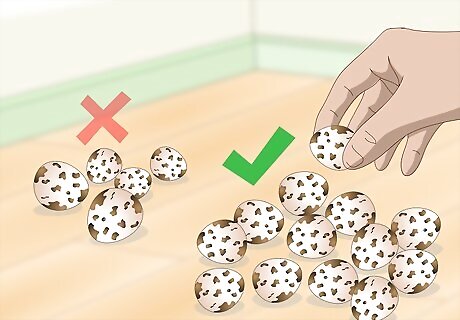
Select high-quality eggs for hatching. For the highest chances of hatching, choose the best eggs you can find. Look for eggs that are clean, have hard shells, and are free of cracks and deformities. Avoid picking eggs that are unusually small or large. Do not wash or rub the eggs. The eggs have a special coating which protects them from bacteria, and by causing friction or washing the eggs you get rid of the special coating.

Store the eggs at 55–65 °F (13–18 °C) until you’re ready to incubate them. Once you collect the eggs, you’ll need to store them at a low enough temperature to keep them from developing until you’re ready to begin incubation. Place the eggs in cartons, large end up, in a cool space where you can keep the temperature between 55–65 °F (13–18 °C) and the relative humidity around 75%. Don’t store the eggs any longer than 10 days before incubating them, since their hatchability will begin to decline after that time. Turn the eggs if you have them in storage for more than a week. You can increase the humidity level in the storage area by placing a shallow pan of water near the eggs. Purchase an indoor humidity meter at a pharmacy or home supply store to monitor the humidity level in the room. Before incubating the eggs, remove them from the cool storage area and allow them to warm up gradually to room temperature. This will reduce condensation on the eggs, which can stimulate the growth of harmful bacteria on the shells.
Incubating Quail Eggs
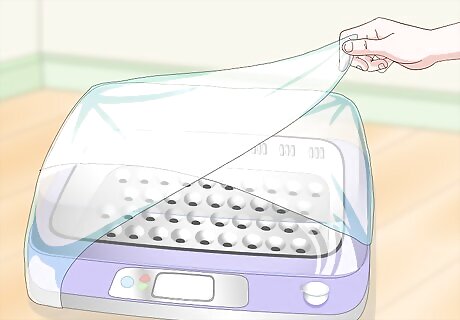
Purchase or build an incubator. To hatch your quail chicks, you'll need a high-quality incubator, preferably with a built-in egg-turner. You can purchase an incubator online or from a ranch supply store. Look for a forced-air incubator with a fan to distribute heat and humidity evenly and keep the eggs well-ventilated. If you don’t want to purchase an incubator, you can build your own using basic supplies that you can buy in any hardware store or find around the home. It’s a good idea to get the incubator up and running 24 hours before you’re ready to set the eggs. This can help ensure that the incubator is running properly before you use it and that conditions are right when you put the eggs in. If you’ve used the incubator before, make sure it’s clean before you put any eggs in it to prevent microbial growth and contamination.
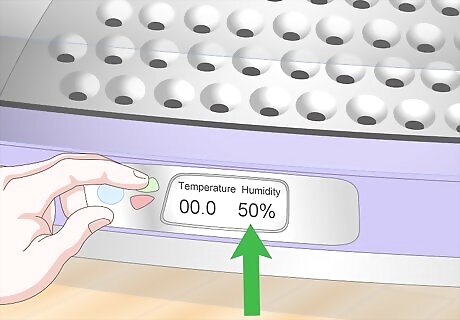
Set the humidity of the incubator at 50%. Depending on the type of incubator you have, you may need to add water to a pan or trough in the incubator daily. Monitor the humidity level carefully to make sure it doesn’t get too low or too high. While around 50% humidity works for most quail varieties, some breeds, such as bobwhite and jumbo quail, do better at 55-60%. If the humidity level is too low, the egg shells and membranes may become to hard and thickened for your chicks to break through. Humidity that is too high can also make hatching difficult or cause the chick to drown in excessive fluids.
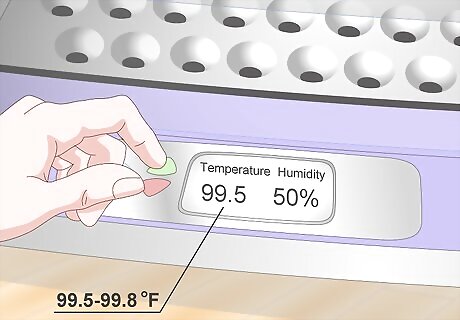
Warm the incubator to 99.5–99.8 °F (37.5–37.7 °C). You’ll need to keep your eggs evenly and consistently warm to encourage embryonic growth. If you have a still air incubator, set the temperature a little higher, at around 100–101 °F (38–38 °C). Put several thermometers in different parts of the incubator so that you can check to make sure that the incubator is evenly heated to the right temperature. Check these thermometers multiple times daily so you can detect any temperature fluctuations. If your incubator is unevenly heated or you notice a lot of temperature changes throughout the day, this may mean the incubator isn’t properly insulated.
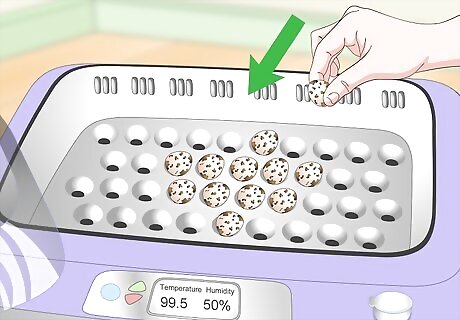
Place your fertile eggs in the incubator. When you’re ready to set the eggs, put them in the incubator with the small end facing downwards and the big end sticking up. Positioning the eggs properly can help prevent deformities and other health problems in the chicks.Tip: You may notice that the temperature drops and the humidity level changes right after you set the eggs. Don’t be alarmed if this happens—it should correct itself within a few hours as the eggs warm up and conditions in the incubator equilibrate. The eggs should take about 17-25 days to hatch depending on what breed of quail produced them.
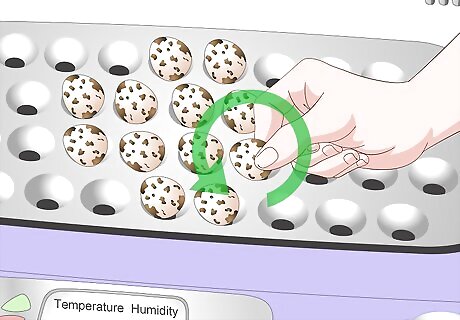
Turn the eggs several times a day. Turn the eggs at least 3 times a day to stop the embryo in the egg from sticking to the shell. You can set the turner in the incubator to do this for you. If you don't have a mechanical egg turner in your incubator, no worries; you can just turn the eggs carefully by hand. If you’re turning the eggs by hand, you might find it helpful to mark an X on one side of the shell so that you can tell whether you’ve turned them. Stop the process of turning the eggs 3 days before the hatch due date.
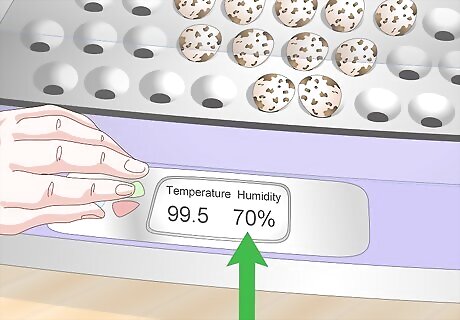
Raise the humidity level a few days before the hatch date. After about 23 days of incubation (or roughly 3 days before the hatching due date, which may vary depending on your type of quail), raise the relative humidity level to 65-70%. This will help soften the shells, making hatching easier. It can also prevent the chicks from becoming dehydrated during the long hatching process. The preferred humidity level for incubation varies a little depending on the breed of quail you’re hatching. As a rule of thumb, increase the humidity level by 15% from whatever it was during most of the incubation period.
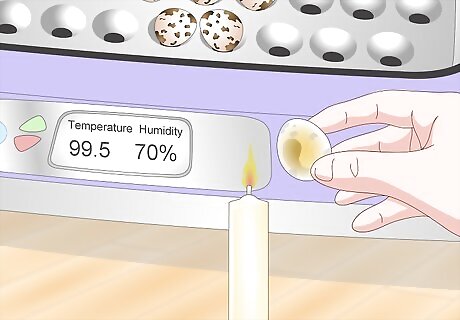
Start checking on the eggs before the hatch due date. About 7-10 days in, check on the eggs to make sure they’re developing properly. You can do this by holding the eggs in front of a candle or other light source and looking for a network of veins inside. Remove any eggs that don’t have any obvious blood vessels in them, as these are likely not viable. You may have a hard time seeing through especially dark or spotty eggshells. Continue to check the eggs occasionally throughout the incubation process. By around 3 days before the hatch date, you should be able to see a large, dark mass in the egg beneath the air sac at the wide end. Don’t be alarmed if your chicks begin to hatch a little earlier or later than you expected.
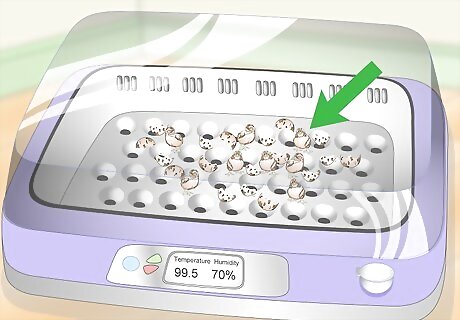
Allow the chicks to hatch in the incubator. About 3 days from the hatching due date, stop turning the eggs. You may wish to remove the mechanical egg turners if your incubator has them. Put down some non-skid material, such as rubber shelf liner, to prevent the newly hatched chicks from slipping around on the floor of the incubator. Keep the incubator closed and observe the eggs closely once pipping begins. Hatching is a long and difficult process, and it may take a little over 24 hours for each chick to emerge. Discard any eggs that aren’t hatched within 1-2 days after the due date. Wait until the chicks are at least 90% dry before taking them out of the incubator.
Moving the Chicks into the Brooder
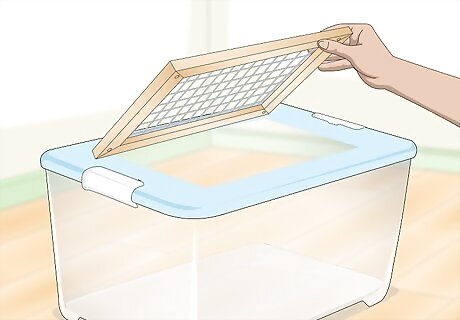
Set up your brooder a few days before the chicks hatch. A brooder is a small box that you will use to house the chicks for their first 5-6 weeks of life before they move to their main living area. It should provide shelter, warmth, space, food and water. You can use a simple cardboard box or a large plastic storage tub as a brooder. Tip: As an alternative to bedding, consider placing wire mesh at the bottom of the brooder. A wire bottom will allow droppings to fall through so that you don’t have to clean the brooder as frequently. Use .25 in (0.64 cm) mesh for the first 2-3 weeks, then switch to .5 in (1.3 cm) mesh as the chicks get bigger. The brooder should be large enough to house your chicks comfortably. Aim for .5–1 square foot (0.046–0.093 m) of space per chick. Place bedding in the brooder, such as straw, paper towels, or pine shavings. Avoid cedar shavings, since these are toxic to the chicks. Quail chicks are messy, so be prepared to clean the brooder and change the bedding at least once a week! In addition to bedding, the brooder should contain a shallow water dish, chick crumbles (baby gamebird starter food works best), and an infrared heat lamp.
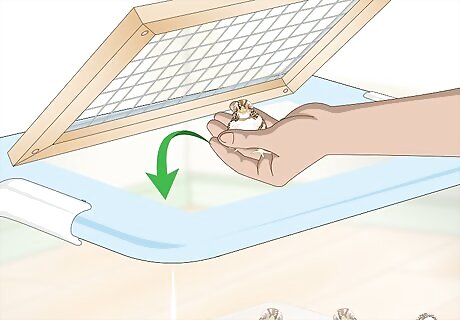
Move the hatched chicks to the brooder. Once the chicks are dry, transfer them to a previously set-up brooder. Take care not to drop any of the chicks as you are moving them over. Dip each chick’s beak in the water dish as you transfer them over to encourage them to drink immediately after hatching.
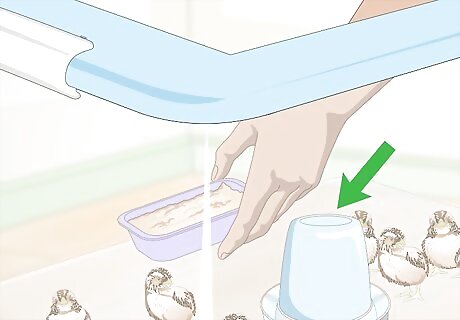
Provide the chicks with fresh food and water daily. Set up a shallow water dish or a chick waterer in the brooder and make sure that fresh, clean water is available at all times. Put down some paper towels in the bedding area and sprinkle crushed up, high-protein game bird starter food on them. You may need to guide the chicks to the food for the first day or 2 after hatch by tapping on the paper towels close to the food. Keep the water shallow and place small stones or marbles in the dish or around the base of the waterer to prevent your chicks from drowning. You can also prevent spills and drowning by using a nipple waterer. After about 3 days, you can remove the paper towels and sprinkle the food directly on the bedding. The chicks should be able to find it more easily by then. You can stop crushing up your chicks’ food by the time they’re around 1-2 weeks old.
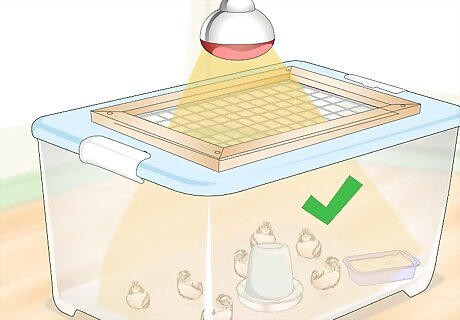
Keep the chicks warm while they’re in the brooder. Set up an infra-red heat lamp and keep the temperature in the brooder around 95–97 °F (35–36 °C) for the first week or so of brooding. After that, turn down the heat by 5° F each week until you reach around 70 °F (21 °C). Place thermometers low in the brooder (at chick height) so that you can make sure you are maintaining an appropriate temperature. Putting the thermometers too high may give you an inaccurate reading.










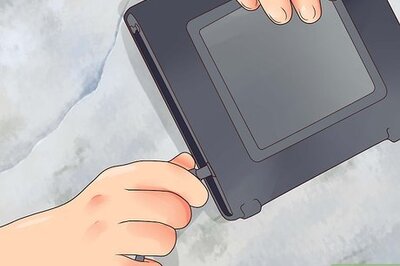
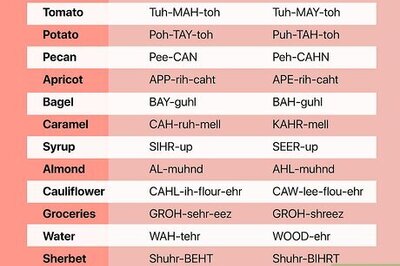




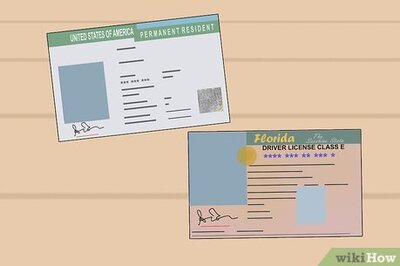
Comments
0 comment